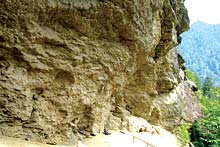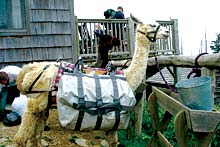I am a social hiker. For me, one of the highlights of hiking is meeting friendly and energetic people on the trail. That’s why I love the camaraderie at LeConte Lodge, which perches atop Mount LeConte at 6,593 feet. Reachable only on foot, the lodge is luxurious considering its location. Groups come here for family reunions, and some people exercise for weeks before attempting the trip, because it’s the only hiking they do all year.

Mount LeConte, the third-highest mountain in the Smokies, rears up a mile from its base. It can be reached by five different trails. Most day-trippers take the Alum Cave trail because it’s the shortest route to the top, but it’s also very steep. For a challenging day hike, my favorite combination is to take the Appalachian Trail from Newfound Gap, spur off on the Boulevard Trail up LeConte’s flanks (8.2 miles) and return via the Alum Cave trail (5.1 miles).
The first 2.7 miles on the AT can be crowded, since it’s also the way to Charlies Bunion, a popular viewing area, but once you leave the AT, you’ve lost the herds. On the Boulevard Trail, if you’re up for an extra mile, follow the sign pointing right to the Jumpoff, a sheer, thousand-foot vertical cliff. On a clear day, you’ll get amazing eastern views of Charlies Bunion and the surrounding wilderness.
The Boulevard Trail, which stays above 5,500 feet, is always cool. When it curves around the eastern side of the mountain and gets steep and rocky, you’ll know you’re getting close to the top. Pass the trail marker to Myrtle Point (which offers an incredible sunrise view but is worth a detour any time of day). At High Point, LeConte groupies are given to adding rocks to a pile so that eventually, the mountain will be higher than Clingmans Dome. Let’s just say they have a long way to go.
Heading down, the Alum Cave Trail cuts across a rock face that may be covered with ice in spring. About halfway down, Alum Cave Bluffs is a bone-dry island in one of the wettest regions in the country. The soil contains magnesium sulfate and other minerals and led to the start of the Epsom Salt Co. in the 1830s. During the Civil War, William Holland Thomas and his band of Cherokees built a road to the Bluffs to protect its store of saltpeter, an important component of gunpowder. Farther down, you’ll go through Arch Rock on rocky steps. From there, the trail follows an easy course along the river to your car.
The Lodge

There are two overnight options on Mount LeConte: the newly refurbished backcountry shelter or the lodge, which consists of a group of furnished cabins. The beds have sheets and three blankets, so there’s no need for a sleeping bag. There’s no electricity or running water, however. If you feel the need to wash up before dinner, take a washbowl from your cabin and fill it with warm water from a faucet outside the dining hall.
The historic lodge actually predates the park. In 1924, David Chapman guided some VIPs on a trail ride, seeking to persuade them to create a national park here. First, a tent camp was erected. Later, Jack Huff began building the lodge as a retreat. Ten years later, Huff and his wife, Pauline, chose Myrtle Point for their mountaintop wedding. Jack Huff built a special chair to carry his mother up to the lodge. You can see that picture in the lodge’s library/office. The office is also the only place around to purchase LeConte T-shirts. LeConte Lodge is now operated as a concession under the supervision of the National Park Service.
The lodge serves a hearty dinner and breakfast, so all you need in addition to your day-hiking gear is a toothbrush, a small towel and a flashlight. After dinner, guests gather for the outstanding sunset at Cliff Top, a wide expanse of rocks a short way from the lodge. In the morning, be prepared to creep quietly out of your cabin in the dark with your flashlight and walk to Myrtle Point to watch the sunrise, an unforgettable and generally more private experience.
Supplies are brought up to the lodge by helicopter several times a year and by llamas three times a week. Llamas are much gentler on the trail than the horses that used to do the job. The llamas generally pack on Monday, Wednesday and Friday using the Trillium Gap Trail, north of Gatlinburg. If you’re on top on llama days, you may see these gentle animals from the dining-room porch, getting saddled with dirty linens and trash to carry out.
All this comfort costs $97 per person plus tax.
Getting a reservation
The lodge begins filling reservations on Oct. 1 for the next season, which runs from the end of March to the end of November. If you call now (865) 429-5704 and can go on a weekday, you might still get a place this year. But remember, the lodge is well above 6,000 feet: In November, that means full winter conditions.
For 2008, you must either plan ahead or be flexible with your dates. To get a reservation, write a postal letter now, giving several dates and stating the number of people in your group. Follow this up with an e-mail—all before Monday, Oct. 1. Slots are assigned via a lottery system. Trying to telephone is a hopeless exercise—the phones are constantly busy for weeks after Oct. 1. For details about the reservations process, go to leconte-lodge.com.
If you can’t commit that far in advance, try calling next spring. If you’re flexible and your group consists of only a few people, you just might be able to get in.
As you sit around the dining-room table, you may hear about groups that have been “grandfathered.” Groups that had a tradition of visiting the lodge year after year on the same date could count on getting that date into perpetuity. But if they miss a year, they lose their date, so it’s becoming less common. For new groups, this practice was stopped years ago.
But other than that, the lodge roster doesn’t carry over from year to year: Everyone is equal. So plan ahead, and good luck.
[Hike leader and outdoors writer Danny Bernstein is the author of Hiking the Carolina Mountains. She can be reached at danny@hikertohiker.com]



Before you comment
The comments section is here to provide a platform for civil dialogue on the issues we face together as a local community. Xpress is committed to offering this platform for all voices, but when the tone of the discussion gets nasty or strays off topic, we believe many people choose not to participate. Xpress editors are determined to moderate comments to ensure a constructive interchange is maintained. All comments judged not to be in keeping with the spirit of civil discourse will be removed and repeat violators will be banned. See here for our terms of service. Thank you for being part of this effort to promote respectful discussion.